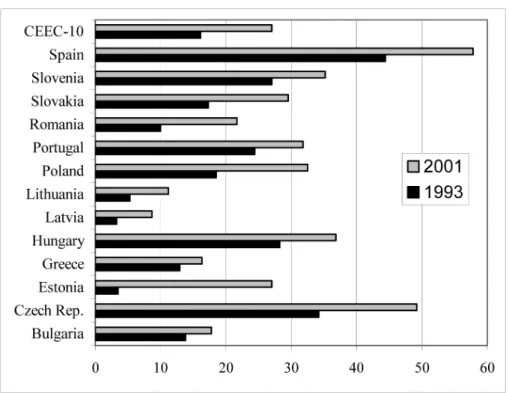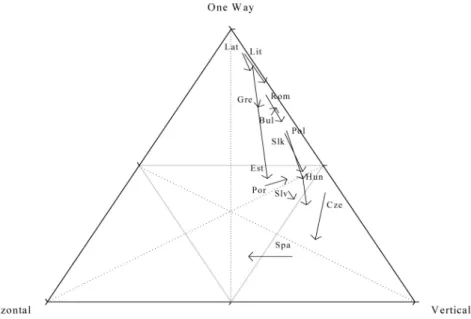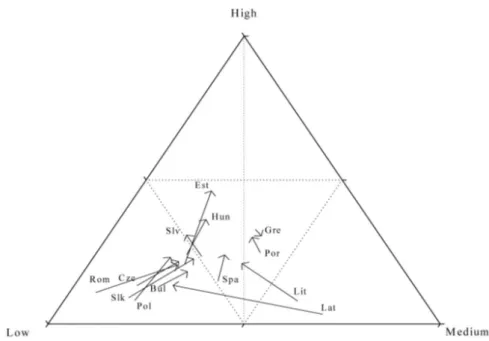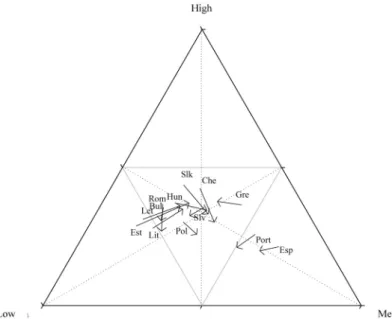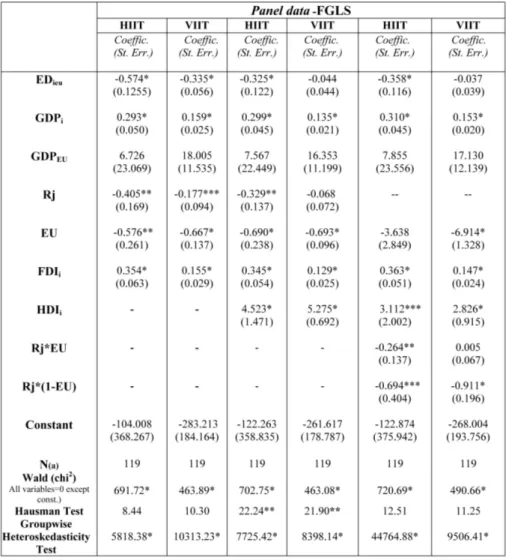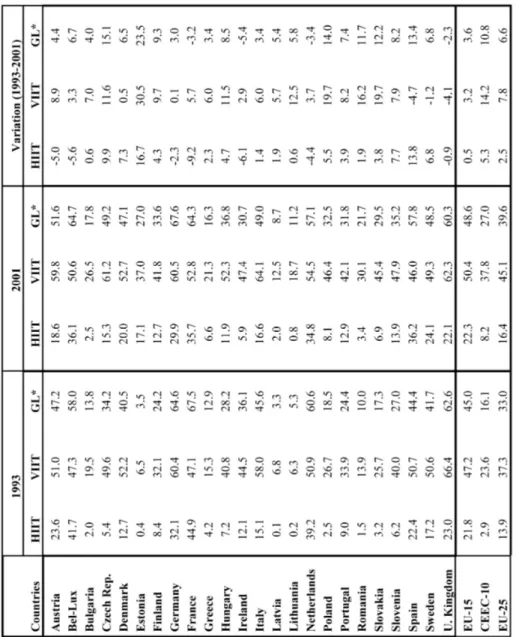Abstract
In this paper we characterise the dynamics of trade among Central and Eastern European Countries (CEEC) and the EU using several methodologies that evalua-te the type of trade and price-quality ranges. The analysis shows a significant decline in inter-industrial trade and an increasing specialisation in vertical intra-industry trade (IIT). Moreover, we found substantial differences in the unit values of exported and imported goods, which suggest that the increasing weight of IIT in the EU-CEEC trade did not result from a convergence on the factorial contents of the traded goods. Using a panel data approach we also identify the determi-nants of both vertical and horizontal IIT. The results suggest that there are some differences in the determinants of these types of trade, although both seem to have a statistically significant relationship with a country’s size and foreign direct investment.
JEL Classification: F14, F15
Keywords: Intra-industry Trade, European Union enlargement, Panel data
* Corresponding Author: Department of Economics and CEFAGE, Largo dos Colegiais nº 2, 7000-803 Évora, Portugal, e-mail: jcaetano@uevora.pt
A previous version of this paper was presented to the “First Iberian international Business Confer-ence”, Porto, Portugal, September 2005.
IN SEARCH FOR THE DETERMINANTS OF INTRA-INDUSTRY
TRADE WITHIN AN ENLARGED EUROPE
JOSÉ CAETANO
*AURORA GALEGO
1. Introduction
Following the pioneering work of Grubel-Lloyd (1975), revealing the existence of both exports and imports of goods which are grouped in the same industry (intra-in-dustry trade - IIT), an abundant theoretical and empirical literature has evaluated this phenomenon and its foundations. Theoretical models have suggested that IIT is deter-mined by both country-specific factors (income levels, economic dimension, endow-ments and foreign investment) and industry-specific factors (market structure, pro-duct differentiation, economies of scale). Yet, empirical studies have found stronger support for country-specific determinants (Greenaway,et al. 1994 ; 1995).
More recent literature considers IIT segmentation taking into account the type of goods’ differentiation. Vertical differentiation is related with different levels of quality of the goods generating vertical intra-industry trade (VIIT), while horizontal differentiation is based on the different attributes or varieties of goods of the same quality, originating horizontal intra-industry trade (HIIT). Theory confirms that the bases and the effects of the two types of flows are different. In respect of VIIT, pro-duct differentiation based on quality follows the Heckscher-Ohlin model, where a comparative advantage comes from resource endowments and factor proportions. As for HIIT, the issues related to imperfect competition and market structures play a decisive role.
In terms of economic policy, this framework helps us to evaluate the adjustment costs associated with changes in trade patterns. The adjustment effects in the case of HIIT are less serious than the ones that occur in presence of patterns of inter-indus-trial specialization or of VIIT (Brulhart and Elliott, 2002). In fact, differences in the quality of the goods derive from differences in the skill content, which makes labour mobility more difficult.
Theoretical differences in the types of trade have stimulated a vast empirical re-search trying to identify the nature and the determinants of each type of trade. If we just focus on the relationships between the old members of the European Un-ion (EU-15) and the Central and Eastern European Countries (CEEC), over the last decade, the intensity and nature of trade have changed considerably. The political and economical opening up has spurred foreign direct investment (FDI) flows, thus stimulating economic restructuring and industrial modernisation. In spite of the fact that inter-industry trade still prevails (Caetano et al., 2002), recent empirical research points to structural changes in the nature of trade, uncovering an increase in the two-way trade of goods in different quality ranges.
These developments make the analysis of trade intensity and determinants within an enlarged Europe relevant and opportune. However, empirical research on the de-terminants of the EU-CEEC trade structure lags behind research on other regions in the world. In this paper we try to contribute to a better understanding of recent EU-CEEC trade developments. The main objectives are to characterise the major
trends in the nature of the EU-CEEC trade as well as to identify the determinants of the different types of intra-community trade. We apply the methodology of Abd-el-Rahman (1991) in order to disentangle HIIT and VIIT and focus on country-specific determinants.
This paper includes several features that may be considered as improvements over earlier studies. First, we update and extend previous studies by analysing more recent data and employing several methodologies, which evaluate the types of trade and the quality range of the goods. In order to obtain more accurate results we use data with a high level of industry disaggregation. Second, unlike most previous studies, for identifying the determinants of IIT in the CEEC-EU trade, we consider a panel data approach and regress both VIIT and HIIT on some possible explanatory variables. Moreover, previous studies typically focus on the analysis of the trade relations be-tween each CEEC and the EU-15 countries, whereas we consider trade bebe-tween the EU and each of the 25 countries of the enlarged Europe.1
The structure of the paper is as follows. The next section reviews the theoretical foundations of IIT and some results of empirical research are presented. Section III examines the developments in the intensity of HIIT and VIIT, taking into account the quality ranges in trade. Particular attention is given to the comparison of the CEEC with the Iberian countries and Greece. In section IV, we investigate the determinants of IIT, presenting the econometric modelling and discussing the results. Section V sums up the main findings of the paper and presents some final remarks.
2. Brief Survey of the Literature on Intra-industry-trade and Product Differen-tiation
Until the 1980’s, most literature on IIT assumed product differentiation within a horizontal framework, considering these flows as two-way trade among developed countries, with similar technology, income and factor endowments. Krugman (1979) introduced horizontal differentiation, by extending the models of monopolistic com-petition to trade. Falvey (1981) and Falvey and Kierzkowski (1987) have provided theoretical support to vertical differentiation, by associating VIIT with trade in simi-lar goods of different quality levels. These authors admit the same type of explana-tion for VIIT flows and for inter-industry trade, assuming that capital-abundant coun-tries specialize and export high quality products, while labour-abundant councoun-tries specialize in low-quality products. Hence, trade patterns are explained by differences among the countries in factor endowments, technology and in the pattern of income distribution.
Shaked and Sutton (1984) explain the influence of the market structures in VIIT flows in a context of oligopoly competition, which leads to price reductions in the higher quality goods and to the disappearance of lower quality goods. In the long run, firms’ survival depends on improvement of the products quality and on economies of scale, which can lead to the emergence of “natural” oligopolies. Likewise, Flam and Helpman (1987) stressed the importance of technological and income differences between countries in explaining IIT flows. They found that the North-South trade structure is determined by these differences, which explain why the North exports industrial products of high quality and imports industrial products of lower quality from the South.
As most empirical studies have found evidence that vertical differentiation is predominant2, theoretical models of VIIT aroused unexpected interest. Researchers
were led to test whether this type of trade would be determined by the factor propor-tions explanation of the comparative advantage instead, of the common factors of the imperfect competitive context predicted by the monopolistic competition theory3.
Thus, not surprisingly, several different approaches to this phenomenon coexist to-day.
Empirical research has tried to identify the determinants of different types of trade in many countries. In respect of EU-CEEC trade empirical analyses are scarce. A small number of studies have identified an increase in the weight of IIT and suggested several determinants for it. In an early study, Hoekman and Djankov (1996) identify high increase in IIT in EU-CEEC trade and cite exports performance and economic growth as determinants. According to Freudenberg and Lemoine (1999), most of IIT in the EU-CEEC relationship involves vertically differentiated goods and CEEC ex-port mainly lower quality products. Also, using specific variables for industries, Atu-rupane et al. (1999) found evidence of a positive relation between the volume of VIIT and economies of scale, labour intensity of production and FDI flows. As for HIIT, they found a positive relation between FDI flows, industry concentration and product differentiation, together with a negative relation with economies of scale and labour intensity of production.
2. Particularly in trade among European countries (Aturupane et. al., 1999; Brulhart and Hine, 1999).
3. In fact, new developments have been emerging within the context of factor proportion models. For instance, Schott (2003) by using a new technique for testing HO model has showed that tra-ditional product categorizations hide fundamental cross-country specific product differences. In addition, Tombazos et al. (2005) clarifies how trade interactions between goods and factor costs regulate important aspects of world trade, under which both endowments and technology may determine the pattern of specialization and the international division of labour.
Including FDI flows as a regressor opens new perspectives for understanding the relation between trade structures and productivity convergence. In fact, FDI in the CEEC has grown together with the intensification and transformation of trade pat-terns and its role in technology transfer has been extensively documented (Gabrisch and Segnana, 2003). Damijan et al. (2001) found that productivity has grown more swiftly in firms with foreign capital, even though there are no records of spillover effects within the industries. Hence, one important question is whether FDI explains both horizontal and vertical IIT flows. If FDI has a stronger relation with VIIT, the role of FDI in promoting productivity convergence is small. This is particularly im-portant as FDI flows seem to have failed in promoting significant technological and organisational dissemination effects for domestic firms that resulted in narrow posi-tive externalities between industries.
3. Recent trends in Intra-industry trade between CEEC and EU
To perform a detailed analysis of the intra-industry specialisation pattern in CEEC-EU trade relations, we applied several methodologies to study the nature and types of trade for the period from 1993 to 2001. We focus on the trade between each CEEC and the EU-15 and also on the trade between the Iberian countries, Greece and the rest of EU-15. We pay particular attention to Greece and the Iberian countries, as these countries presented production and trade structures similar to the CEEC before EU membership. Moreover, previous studies have also stressed that the recent EU enlargement may affect these countries more in terms of competition (for example, Caetano et. al., 2002).
First, we analyse the geographical dimension of IIT by using the Grubel-Lloyd index (1975). This is followed by the use of Abd-El-Rahman (1991) methodology to identify the types of trade and to study the quality ranges of exports, respectively. The first approach is based on the level of trade overlap and it is considered more appro-priate to study IIT among countries with similar factor endowments. The results of the IIT indicator4 confirm the increase in this type of trade, which in 2001 represented
about 27% of total CEEC-EU trade, although this value is still inferior to the one dis-played in Intra-UE trade relations (see figure 1). There was a generalised growth in IIT, which led to a convergence in the values of IIT for the several eastern countries and, in fact, some of them like Czech Republic, Hungary and Slovenia display in 2001 values of IIT that are already higher than those of Portugal and Greece.
4. In this paper we analysed IIT from each CEEC and each Iberian country and Greece relatively to the EU as a whole and to each of the trade partners, using the Grubel-Lloyd index, which can be seen in the appendix. Following reference studies in this field, we employed highly disaggregated data (5 digits - SITC classification, involving about 3750 items) from COMEXT (EUROSTAT).
Figure 1. IIT with EU for 1993/2001 (% total trade)
Source: Data base COMEXT – EUROSTAT; authors’ calculations. Note: Cze (Czech Repub-lic); Hun (Hungary); Slv (Slovenia); Pol (Poland); Slk (Slovakia); Est (Estonia); Rom (Romania); Bul (Bulgaria); Lit (Lithuania); Lat (Latvia); Spa (Spain); Por (Portugal); Gre (Greece).
Considering IIT in bilateral terms between the current EU members5, we conclude
that these are clearly higher for geographically close countries, especially for those sharing the same border (see Caetano et. al., 2002). In the year 2000 the Czech Re-public, Hungary and Slovenia display levels of IIT with Germany and Austria which are clearly higher than those registered among many of the 15 members of the EU at the time. Also, Greece and Finland registered values of ITT with some of the CEEC which were higher than those for their relations with the EU members. This confirms the importance of geographic proximity in the intensification of bilateral IIT. Taking into account exports and imports prices, Abd-El-Rahman (1991) deve-loped a methodology to distinguish three types of trade: one-way trade, horizontal two-way trade (HIIT) and vertical two-way trade (VIIT)6.
5. Excluding Cyprus and Malta.
Figure 2. Types of trade between CEEC and EU for 1993/2001
Source: Data base COMEXT – EUROSTAT; authors’ calculations. Note: Cze (Czech Repub-lic); Hun (Hungary); Slv (Slovenia); Pol (Poland); Slk (Slovakia); Est (Estonia); Rom (Romania); Bul (Bulgaria); Lit (Lithuania); Lat (Latvia); Spa (Spain); Por (Portugal); Gre (Greece).
The results displayed in figure 2, reveal that although one-way trade (inter-in-dustry trade) still prevails, there was a significant reduction in its share, with the exception of Bulgaria. Nevertheless, in the majority of the new member states the inter-sectoral pattern is still predominant. Simultaneously, there was an increase in vertical two-way trade in all countries apart from Bulgaria, representing about 52% of trade with the EU. Finally, horizontal two-way trade is starting to gain some im-portance, representing in some countries a percentage between 11.9 and 17.1 in 2001 (particularly in Estonia, Slovenia, Czech Republic and Hungary). On the other hand, the Iberian countries present different trends: while in Portugal VIIT has increased, in Spain HIIT has grown.
Considering the values of IIT and the weight of VIIT on total IIT we get two groups of countries. The first includes Estonia, new member countries of central Eu-rope and Portugal that have a higher level of IIT, particularly in vertically differentia-ted goods. Nevertheless, in the last few years, in some of these countries the weight of HIIT is starting to be important. The second group includes Lithuania, Latvia, Bulgaria, Romania and Greece with a value of IIT inferior to 20% of total trade, and almost all VIIT. Therefore, one may conclude that in spite of the increase in IIT in all
the countries, the specialisation patterns of the recent entrants in the EU are becoming increasingly heterogeneous, reflecting different factor and technological contents. The dynamics of these two groups seem to be quite different. The most developed countries display better performance in the production of differentiated goods, com-peting in market segments with similar prices to the ones in Western Europe. This si-tuation may be related with high FDI inflows, higher labour skills and higher effort in innovation (European Commission, 2004). On the other hand, those countries which reinforced the vertical differentiation pattern compete in less sophisticated markets and anchor their competitiveness in the production of goods intensive in cheap labour and with low technological contents.
Due to the dynamics of trade flows in vertically differentiated two-way trade, it is important to identify the market segments where the CEEC exports are positioned when they access the community markets. Thus, we identify the quality ranges of goods, comparing average export prices with the prices in intra-EU trade. Following previous studies, we consider unity values as a proxy for quality, in the sense that the price level reflects the goods quality7. The price-quality structure of all the CEEC
and the Iberian countries was examined, with reference to the average unit value of imports and of exports of the EU, respectively.
The situations were typified into three categories: 1) whenever the export (import) price of each country is above the EU average by more than 15%, the flow is con-sidered high quality; 2) If the first is below the second by more than 15%, the flow is classified as low quality; 3) all other cases are considered medium quality.
The results allow us to conclude that most of CEEC exports to the EU are of low quality products, although a favourable evolution has occurred, decreasing from 70% in 1993 to 56% in 2001 (see figure 3). On the contrary, the weight of high quality goods in those countries’ exports is still low, in spite of having almost doubled, from 9.5% to 18.9% during the period. The Iberian countries display a more balanced structure which has been more stable over time. Hence, there was a clear convergence between these two groups of countries, with Estonia, Slovenia and Hungary present-ing a higher share of high quality of exports to EU than Portugal and Spain do. The evolution was very similar for the several countries, except for Lithuania and Latvia where the share of low quality goods has increased.
7. Although the use of price to infer quality is not without critics, there is no consensus on alterna-tive measures, especially due to the lack of suitable information on the data sets available for trade. In fact, the unit value has been largely applied in the study of trade quality (Fontagné and Freudenberg, 1997 and Freudenberg and Lemoine, 1999). Here we use the Freudenberg and Müller (1991) methodology.
Figure 3. Price-quality of exports to the EU - 1993/2001
Source: Data base COMEXT – EUROSTAT; authors’ calculations. Note: Cze (Czech Repub-lic); Hun (Hungary); Slv (Slovenia); Pol (Poland); Slk (Slovakia); Est (Estonia); Rom (Romania); Bul (Bulgaria); Lit (Lithuania); Lat (Latvia); Spa (Spain); Por (Portugal); Gre (Greece).
Boeri and Brücker (2000) have detected the same trends and according to them the reduction of low range exports in the CEEC is due to the fall of natural resource ex-ports and to the increase in exex-ports of goods with higher technological content, whose production and distribution is controlled by multinational firms. Thus, in agreement with Freudenberg and Lemoine (1999), we conclude that the CEEC position in terms of price/quality suggests a clear qualitative labour division between the EU-15 and the new member states, even though increasingly heterogeneous in both groups of countries.
As for imports, it is possible to conclude that there was a convergence over the period, as Iberian countries present a higher share of low quality imports and the CEEC reduced the percentage of this type of imports. The increasing sophistication of consumption habits in the CEEC, associated with higher economic growth and a gradual increase of purchasing power have certainly influenced this tendency. Con-sequently, there are some suggestions that globalisation and economic liberalisation have induced a faster convergence in consumption patterns and in production struc-tures.
Figure 4. Price-quality ranges of imports from the EU- 1993/2001
Source: Data base COMEXT – EUROSTAT; authors’ calculations. Note: Cze (Czech Repub-lic); Hun (Hungary); Slv (Slovenia); Pol (Poland); Slk (Slovakia); Est (Estonia); Rom (Romania); Bul (Bulgaria); Lit (Lithuania); Lat (Latvia); Spa (Spain); Por (Portugal); Gre (Greece).
4. An Econometric Investigation of the Determinants of Intra-industry Trade
In this section we estimate a gravity-type model in order to identify the main de-terminants of IIT trade between EU members and the CEEC in the period 1993 to 2001. Many previous studies on IIT between the CEEC and EU, have not considered the difference between vertical IIT and horizontal IIT. Several authors (for example Greenaway et al., 1994) have pointed out that this fact may produce biased estimates. Therefore, in this paper we estimate different regressions for vertical and horizontal IIT and analyse whether there are differences in the determinants of the two types of IIT.
We consider data on horizontal and vertical IIT between each of the 24 countries (Belgium and Luxembourg are considered as one) and the EU as a whole for 1993, 1995, 1997, 1999 and 2001. As a starting point for the analysis we consider the ex-planatory variables proposed by the Helpman (1987) equation for explaining IIT be-tween countries, like economic distance bebe-tween countries (measured by the absolute value of the difference in GDP per capita) and countries’ size (measured by the level of GDP).
We also include in the model other explanatory variables, like distance, a dum-my indicating if the country is an EU member (EU), foreign direct investment as a percentage of GDP (FDI) and the human development index (HDI). In the case of distance we follow closely Fidrmuc and Djablik (2003) and calculate a weighted-av-erage distance to other countries:
where Dj is the distance in Km for the capital cities of the 14 countries (considering Belgium and Luxemburg as one) and wj is the member country’s share of the EU aggregate output.
Unlike other studies we use panel data techniques to estimate a gravity type mo-del. In fact, it is important to take into consideration possible unobservable country effects which may be correlated with IIT. Among these country effects one may con-sider national industry policy or managerial know-how. Our full estimated model is therefore:
where ED stands for economic distance between each country and the EU-15 ave-rage. As in our case we are considering trade between each of the EU-15 and each of the CEEC with the EU as a whole, GDPi represents the GDP of each country and
GDPeu represents the GDP of the EU-15.8
In the previous equation ai represents the country specific effect that is considered
to be constant over the years and εieut is the remainder stochastic disturbance term. γt represents several time dummies to take into account possible business cycle ef-fects.
The Helpman and Krugman (1985) model suggests that IIT is positively corre-lated with countries’ similarity (measured by the difference in GDP per capita) and the level of GDP of each country, and negatively correlated with distance. Therefore we expect β1 and β4 to be negative, as well as, β2 and β3 to be positive. EU
participa-tion may also have a significant effect on the share of IIT even though it is not clear if it should be positive or negative. Falvey (1981) claims that trade liberalisation has a positive effect on vertical IIT. On the other hand, Krugman (1993) argues that in a free trade area countries may specialise more according to their comparative advantages and therefore its effect on vertical IIT should be negative. As the effect of distance might be different for EU member states and countries outside the EU, as Fidrmuc and Djablik (2003) point out, we also estimate an alternative specification allowing for that difference.
(1)
According to the majority of previous studies, foreign direct investment (FDI) is expected to have a positive effect, both on vertical and horizontal IIT. The Human Capital Index (HDI), intends to measure countries´ development, taking into
con-sideration several specific factors (like life expectancy, level of education, poverty measures, and so on). We consider this variable as a proxy of the standard of living of the countries, which is expected to be positively correlated with IIT and especially with horizontal IIT. In fact, according to economic theory high levels of economic development lead to an increasing demand for variety.
Table 1. Determinants of Intra-industry trade in the European Union (1993-2001)
(*) (**) and (***) Denotes values significant at respectively at 1%, 5% and 10% level Time dummies were included but not reported.
(a) the human development index is not available for Slovenia for 1993, therefore our sample is reduced to 119 observations.
Equation (1) can be estimated considering a fixed-effects model or a random-ef-fects model. If the individual efrandom-ef-fects (ai) are correlated with the explanatory
vari-ables, a fixed-effects model should be adopted, if there is no correlation then we have a random-effects model. Hausman tests lead us to conclude that the random-effects model is more appropriate (the tests results are presented in table 1), as only for the second specification could we reject the null hypothesis for a significance level of 5%.
The usual random-effects estimator assumes an homocedastic error structure. Given the nature of our data it is possible that the disturbance variance of the coun-try-specific effect will vary across countries. Accordingly, we performed tests for the existence of groupwise heteroskedasticity and reject the hypothesis of homoscedas-ticity. In order to obtain consistent and efficient estimators the model was estimated by Feasible GLS, correcting for heteroskedasticity.9 All the estimations and tests
re-sults can be seen in table 1.
For several variables the estimates are very stable for the different specifications, like GDPEU, GDP and FDI. As expected, the last two variables both have positive and
significant effects on both types of trade. On the contrary, the GDP of EU, although positive, is never significant, which is in accordance with the results of Fidrmuc and Djablik (2003).
As for economic distance between each country and the EU as a whole the results are stable for horizontal IIT but not for vertical IIT. This variable is negatively cor-related with IIT, which is according to theory, but for vertical IIT it is only significant for the first specification. In fact, when we include the index of human development economic distance is no longer significant.
Referring to the human capital index it seems that it is more significant for vertical intra-industry trade, but it is positively correlated with both vertical and horizontal IIT. This may indicate that the country’s standard of living is an important determi-nant, which is consistent with what was expected.
It is interesting to analyse the results for EU integration and geographical distance, which may be considered as proxies for trade barriers and trade costs. In the first two specifications, EU is negative and significant, although with more evidence for verti-cal IIT. As for distance, the results differ for the two types of IIT. While distance is negative and significant for horizontal IIT, it does not seem too significant for vertical IIT. The results for horizontal IIT are therefore more in line with the Krugman (1993) hypothesis.
9. We have also estimated the model considering the method suggested by Beck and Katz (1995) (OLS with corrected standard errors - PCSE) and the results were very similar to the ones pre-sented.
In the last specification we consider the possible differences on the effect of geo-graphical distance for EU members and non-members. Indeed the results seem to be different for the two types of trade. Contrary to horizontal IIT, for vertical IIT dis-tance is only significant for EU non-members. On the other hand, the EU dummy is no longer significant for horizontal IIT while it is negative and significant for vertical IIT. These results suggest that vertically IIT is more related to CEEC-EU trade rela-tions than to intra-EU relarela-tions.
5. Final Remarks
This paper offers empirical evidence on the major trends in the nature of EU-CEEC trade and on the country-specific determinants of the different types of trade. The paper extends earlier studies, by using more recent data and several methodologies to analyse the types of trade and goods quality. In particular, we consider highly di-saggregated data and focus on trade between each of the 25 countries of the enlarged Europe with the EU-15 as a whole. Furthermore, we consider a panel data approach in order to investigate both vertical and horizontal IIT determinants.
During the transition period, the pattern of comparative advantages in CEEC-EU trade has undergone profound changes in its intensity and nature, and we may con-clude that there are strong indications of convergence towards the EU-15 in the new EU members. Among these, we highlight the expansion of IIT, especially of vertical nature, the emergence of trade flows in similar goods and the improvement in the price-quality range of exports. Nevertheless, there is a persistence of some structural aspects that causes concerns. In fact, there are still important differences between the export prices in CEEC and of intra-EU trade, reflecting the international division of labour in goods of different quality.
Therefore, the increase in VIIT coincided with the reinforcement of the speciali-sation pattern of the CEEC in trade of low quality goods, although it seems that Hungary, the Czech Republic and Slovenia display by now a different pattern. There is, consequently, heterogeneity at the country level, suggesting that geographic pro-ximity to the EU and income convergence stimulated product differentiation and the trade of R&D and capital intensive goods. In fact, according to our results, coun-try size (measured by GDP), income per capita differences and geographic distance seem to be important factors for IIT, especially for horizontal IIT.
Consequently, the pattern of specialisation in CEEC-EU trade still reflects the strong factor complementarity between the two groups. Indeed, the CEEC display a high intensity in low skilled labour and present a high share of capital goods and spe-cialized equipments in their imports. In the old EU members technological processes are intensive in physical and human capital.
In terms of economic policy, one of the significant results is the role of FDI flows in both horizontal and vertical IIT, by promoting structural changes in production
and trade in CEEC, as previous literature and our results highlight. Following the collapse of the centralized economic regimes, the strategies of multinational corpora-tions have stimulated the segmentation of the productive process in human capital and labour intensive activities and have boosted product differentiation.
Appendix I – Methodology
I.A. Intra-Industry Trade Index (IIT)
The Grubel and Lloyd (1975) index measures the degree of trade overlap in a given product:
I.B. Types of Trade
Abd-El-Rahman (1986) developed a methodology that distinguishes between two-way trade in similar products, two-two-way trade in vertically differentiated products and one-way trade. The concept of product is related to its technical characteristics, which may be captured using disaggregated data. Similarity depends on the product unit value, assuming that differences in prices reflect differences in quality. To dif-ferentiate IIT with vertical product differentiation from IIT with horizontal product differentiation, the author employs the following reasoning (Fontagné and Freuden-berg, 1997):
How to define bilateral trade types at product level?
Degree of Overlap between
Export and Import values Do export and import unit values differ less than 15%Similarity of Export and Import Unit Values: Does the minority flow
represent at least 10% of the majority flow?
Yes (Horizontal differentiation)
No
(Vertical differentiation)
Yes in similar productsTwo-way trade Two-way trade in vertically differentiated products
Appendix II -Variables definition and data sources
EDieu- Economic Distance measured by the absolute value of the difference between the real GDP per capita, between each country and the EU.
GDPi- GDP of country i (constant prices)
GDPEU – GDP of EU (constant prices)
Source: Chelem data base
HDIi – human development index
Source : United Nations
FDIi – stock of inward foreign direct investment/GDP in country i
Source: FDI- UNCTAD GDP – Chelem data Base Rj – weighted-average distance to other countries
Appendix III - Tables
Table III.A:
Horizontal and
Vertical IIT
and Grubel-Lloyd Index
*Grubel-Lloyd Index for T
Table III.B:
References
Abd-El-Rahman, K., 1991, “Firms’ Competitive and National Comparative Advantages as Joint Determinants of Trade Composition.”, Weltwirtschaftliches Archiv, 127: 83-97.
Aturupane, C., Djankov, S. and Hoeckman, B., 1999, “Horizontal and vertical intra-industry trade between Eastern Europe and the European Union”, Weltwirtschfliches Archiv, 135 (1): 62-81. Beck, N and Katz ,J. N. , 1995, “What to do with time series cross section data”, American Political
Journal Review, 89, 634-647.
Boeri, T. and Brucker, H., 2000, “The impact of Eastern enlargement on Employment and Labour Markets in the EU Member States - Final Report”, European Commission.
Brulhart, M. and. Elliott, R., 2002, “Labour Market Effects of Intra-Industry Trade: Evidence for the United Kingdom”, Weltwirtschaftliches Archiv, 138, 207-228.
Brulhart, M. and Hine, R., 1999, “Intra-industry Trade and Adjustment: The European experience”, Macmillan, London.
Caetano, J., Galego, A., Vaz, E., Vieira, C. and Vieira, I., 2002, “The Eastward Enlargement of the Eurozone: trade and FDI”, Ezoneplus Working Paper 7, Berlin.
Damijan, J., Majcen, B., Rojec, M. and Knell, M., 2001, “The role of FDI, R&D accumulation and trade in transferring technology to transition countries: Evidence from firms panel data for eight transition countries”, Working Paper 10, University of Ljubljana.
European Commission, 2004, “Third report on economic and social cohesion”, Brussels, http://eu-ropa.eu.int/comm/eurostat/ .
Falvey, R., 1981, “Commercial policy and intra-industry trade”, Journal of International Econom-ics, 11:495-511.
Falvey, R. E. and H. Kierkowski, 1987, “Product Quality, Intra-Industry trade and (im)perfect Competition,” in H. Kierkowski, (ed.) Protection and Competition in International Trade, Basil Blackwell, New York, pp.143-161.
Fidrmuc, J. and Djablík, M., 2003, “Intraindustry trade between the EU and the CEEC´s – The importance of FDI in trade structure”, East-West Conference, November 2-4, Vienna.
Flam, H. and Helpman, E., 1987, “Vertical Product Differentiation and North-South Trade”, Ameri-can Economic Review , 77, 810-822.
Fontagné, L. and Freudenberg, M., 1997, “Intra-industry trade: methodological issues reconsid-ered”, CEPII Working Paper 1.
Freudenberg, M. and Lemoine, F. ,1999, “Central and Eastern European Countries in the interna-tional division of labour in Europe”, CEPII Working Paper 5.
Freudenberg, M. and Müller, F., 1991, La structure du commerce extérieur de la RFA et de la France en 1989: une analyse empirique de la structure du commerce et gammes échangées, Université de Paris I Panthéon-Sorbonne.
Gabrisch, H. and Segnana, M., 2003, “Vertical and horizontal patterns of intra-industry trade be-tween EU and candidate countries”, Final Report of the project “EU Integration and the Pros-pects for Catch-Up Development in CEECs. The Determinants of the Productivity Gap”, IWH: Halle (Saale).
Greenaway, D., Hine, R. C. and Milner, C., 1994, “Country specific Factors and the Pattern of Horizontal and Vertical Intra-Industry Trade in the U.K.”, Weltwirtschaftliches Archiv, 130 (1): 77-100.
Greenaway, D., Hine, R. C. and Milner, C., 1995, “Vertical and Horizontal Intra-industry trade: A cross industry analysis for the United Kingdom”, The Economic Journal, 105 (November): 1505-1518.
Grubel, H. and Lloyd, P., 1975, Intra-industry Trade: the theory and measurement of international trade in differentiated products, McMillan: London.
Helpman, E., 1987, “Imperfect competition and international trade: evidence from fourteen indus-trial countries”, Journal of the Japanese and International Economies, 1:62-81.
Helpman, E. and Krugman, P., 1985, Market structure and foreign trade, Massachusetts Institute of Technology Press: Cambridge.
Hoekman, B. and Djankov, S., 1996, “Intra-industry trade, foreign direct investment and the reori-entation of Eastern European exports”, CEPR Working Paper 1377.
Krugman, P., 1979, “Increasing Returns, Monopolistic Competition and International Trade”, Jour-nal of InternatioJour-nal Economics, 9: 479-479.
Krugman, P., 1993, The current case for industrial policy” in D. Salvatore (ed.) Protectionism and World Welfare, Cambridge University Press: Cambridge.
Schott, P., 2003, “One Size Fits All? Heckscher-Ohlin Specialization in Global Production”, The American Economic Review, 93 (3): 686-708.
Shaked, A. and Sutton, J., 1984, “Natural Oligopolies and International trade”, in Monopolistic Competition and International Trade (ed. H. Kierzkowski), Oxford University Press, Oxford. Tombazos, C., Yang, X. and Zhang, D., 2005, A Neo-Heckscher–Ohlin Model of Trade with
